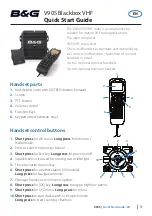
V A L A V I O N I C S L T D
I N S 4 2 9 I N T E G R A T E D N A V I G A T I O N S Y S T E M
I N S T A L L A T I O N A N D O P E R A T O R ’ S M A N U A L
Revision 3
Page 24 of 31
May 2013
SET ACTIVE VOR/LOC FREQUENCY AND RECEIVER FUNCTION
This message is used to set the standby VOR or Localizer frequency as well as the receiver operating
function. The INS 429 can detect if the supplied frequency corresponds to a VOR or a Localizer channel,
so this command will work for both types of NAV aids.
Message format:
$PMRV27E4N<chksm><CR><CR><LF>
This example command would set the active VOR frequency to 117.100 MHz. This can be interpreted by
noting that the ASCII ‘E’ corresponds with 45h, + 30h = 75h, converted to decimal equals 117 for the MHz
portion of the command. The kHz portion converts ASCII ‘4’ to 34h, - 30h = 4h, x 25 kHz steps = 100
kHz. This command would also set the receiver function to normal, leaving the standby channel inactive.
Note: The INS 429 will check input frequencies for validity. An RS-232 serial error message output will be
generated if the frequency is invalid.
SET STANDBY VOR/LOC FREQUENCY AND RECEIVER FUNCTION
This message is used to set the standby VOR or Localizer frequency as well as the receiver operating
function. The INS 429 can detect if the supplied frequency corresponds to a VOR or a Localizer channel,
so this command will work for both types of NAV aids.
Message format:
“V”………..Message class. This is a VHF NAV message.
“28”………Message identifier.
mk………..Standby VOR/LOC frequency:
m = desired frequency in MHz in hexadecimal, where m = desired frequency – 30h,
with desired frequency in range of 108 to 117 MHz.
k
= desired frequency in kHz, where k = (desired frequency / 25 kHz) + 30h,
desired frequency in range of 000 to 975 kHz in 50 kHz steps, or the even numbers
from 30h to 56h.
a………….Receiver function: N = normal, 0 = unchanged.
Example message:
$PMRRV28?PN<chksm><CR><LF>
This example command would set the standby VOR frequency to 111.800 MHz. This is interpreted by
noting that the ASCII ‘?’ corresponds with 3Fh, + 30h = 7Bh, converted to decimal equals 111 for the
MHz portion. The kHz portion converts ASCII ‘P’ to 50h, -30h, -30h yields 20h, x 25 kHz steps = 800 kHz
portion. This command would also set the receiver function to normal, so the receiver would receive only
the active VOR channel.
Note:
The INS 429 will check input frequencies for validity. An RS-232 serial message output will be
generated if the frequency is invalid.








































